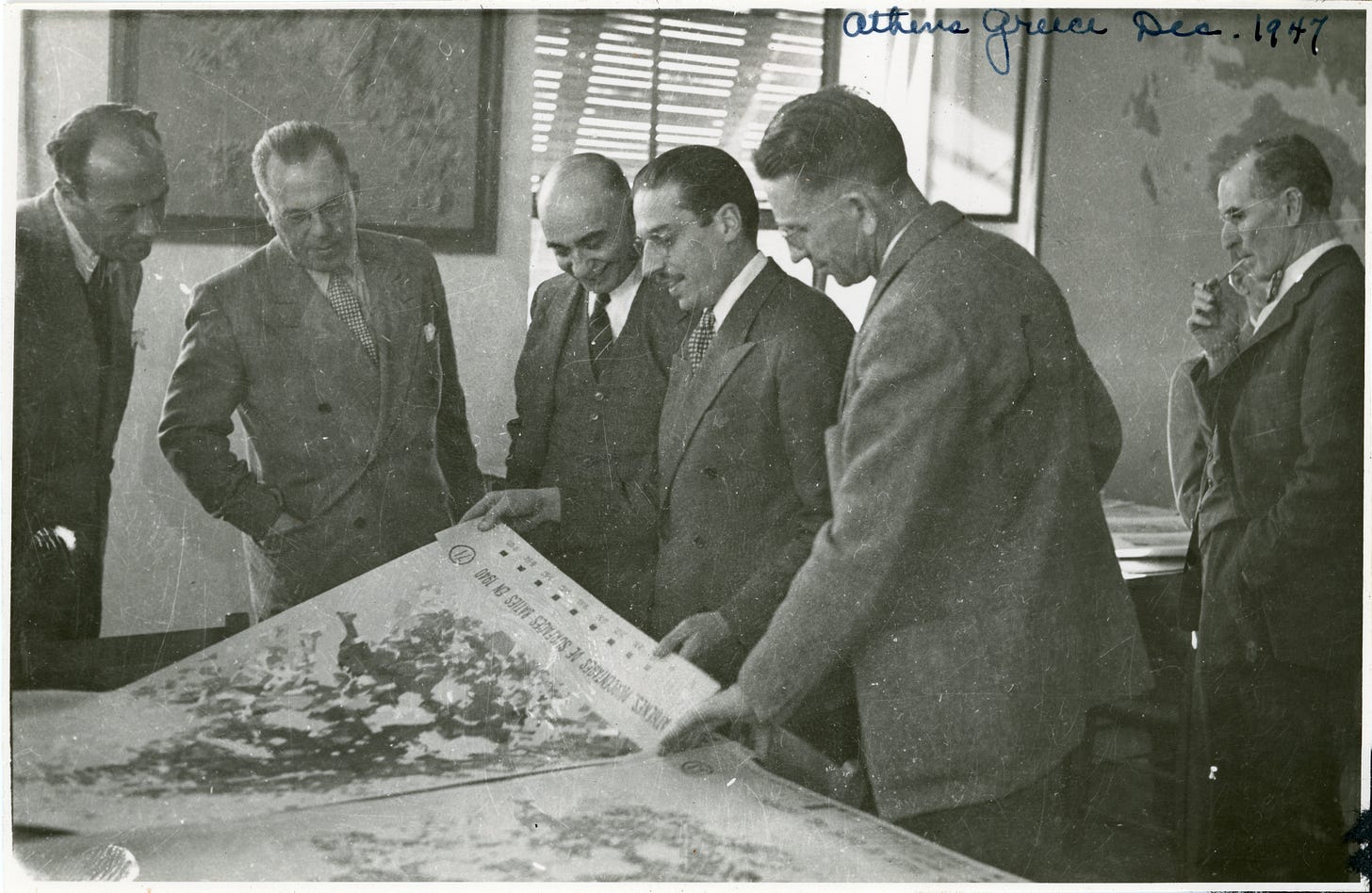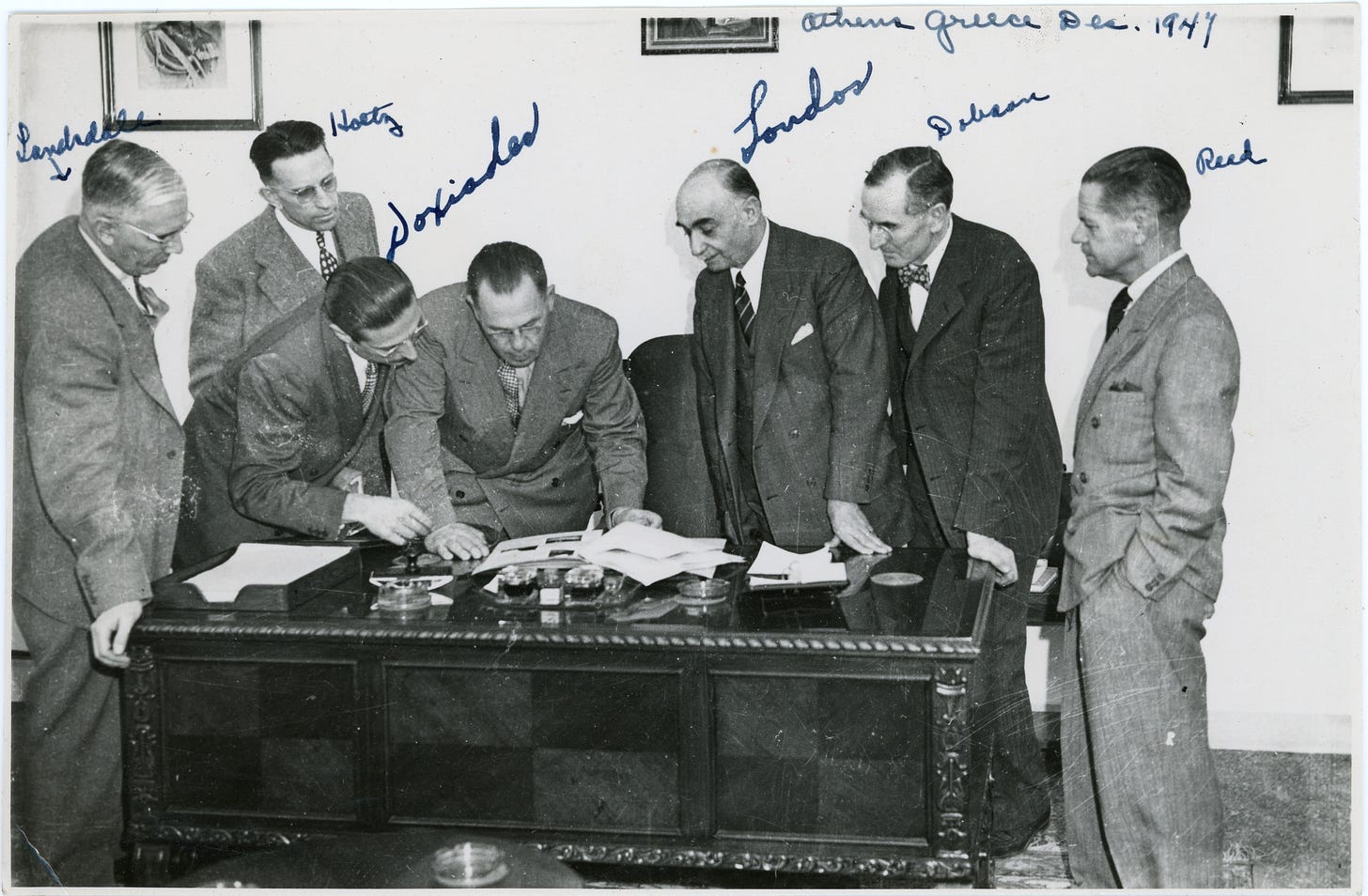This post draws from an article I have published in the latest issue of Ex-Centric Narratives, regarding memoirs of American officials stationed in Greece during the Marshall Plan.

In July 2022, I traveled to the Truman Library on a mission—to find more information about Constantinos Doxiadis and the Marshall Plan in Greece.
In the 1960s, Constantinos Doxiadis was an architect and city planner of global influence. His firm Doxiadis Associates was involved in 40 countries, and most notably designed the capital city of Islamabad, Pakistan from the ground up. But before he transformed himself as the postcolonial planner par excellence, he was the Greek Undersecretary to the Ministry of Coordination, the government department that liaised with the American administrators of the Marshall Plan in that country.
The Marshall Plan, of course, was the US’s extraordinary effort to rebuild Western Europe after World War II so as to stabilize the region economically and thwart the advance of the Soviet Communist bloc. More than $13 billion in 1947 dollars ($183 billion adjusted for inflation) was spent in these efforts, and about $400 million ($6 billion today) was earmarked for Greece and Turkey, the part of the program known as the “Truman Doctrine.” Though Turkey had been neutral in the war, Greece had suffered absolute devastation during the Axis occupation and faced a civil war between the royalist government and Communist insurgents funded out of Moscow.
Of all the Greek officials the Americans worked with during the implementation of the Marshall Plan in Greece, Constantinos Doxiadis was their favorite colleague. With an efficient management style and an intolerance for delays, he was sympatico with the American pace of things. And that aggressive and economical vision led to conflict with his Greek peers.
In November 1950, Doxiadis was hospitalized for a perforated ulcer. And in that time, his superior at the Ministry, Giorgios Papandreou, plotted to oust him. Gathering 30 of his allies in the Hellenic Parliament in the middle of the night on December 19, 1950, they voted to abolish Doxiadis’ position. And when Doxiadis, still bedridden, read the newspaper, he was shocked to see that he was no longer a public servant.
The moment changed Doxiadis’ life forever. He decided to pursue a new life in Australia, bringing his wife and three daughters in tow. However, Australia didn’t recognized his architectural credentials, so he resorted to becoming a tomato farmer. And after two years, he returned to Greece, launching the firm for which he would become known around the world.

When I visited the Truman Library, I was looking for more information on this pivotal period of Doxiadis’ life from the American perspective. The Truman Library had interviewed Doxiadis in the 1960s for an oral history project, so I knew that the library had held an interest in Doxiadis.
Unfortunately, the library’s holdings did not have the wealth of information about Doxiadis which I hoped to find. However, what I did uncover was a very interesting collection of sources. In the 1980s, Paul R. Porter, one of the American officials who led the Marshall Plan efforts in Greece, organized a memoir-collecting effort for the presidential library. Asking his former colleagues and their spouses to contribute memoirs, Porter assembled an impressive range of anecdotes chronicling the travails of a very-green group of diplomats stationed in war-torn Greece. Porter called this ‘collective memoir’ “Greece at the Turning Point,” but in fact America was at the turning point as well—it was the US’s first international aid venture as one of the two dominant superpowers, and Americans were not accustomed to the role.
I’ve just published a peer-reviewed article about these memoirs in Ex-Centric Narratives, an open-access journal out of the Aristotle University of Thessaloniki that focuses on English-language interactions with Greek culture. The (admittedly lengthy) article considers the most interesting stories in the collective memoir, including the experiences of American women in Athens and American perceptions of the Greek Civil War.

It also includes a fascinating revelation about the American reaction to Doxiadis’ dismissal—‘Doxiadis at the turning point,’ you might say. And though I did not find the treasure trove of material about Doxiadis that I had hoped for, on the few occasions when Doxiadis was mentioned in the texts, the references were quite telling.
One of the most interesting stories was supplied by former American Marshall Plan official John Russell, who attached a fictional narrative published by Konstantinos Tsatsos, a prominent politician and literary figure in Athens who eventually became president of Greece. Tsatsos’ story was a purported cache of letters between a Roman senator and the newly appointed Roman governor of Greece, supposedly found in a jar as part of the various real-life papyri found in Oxyrhynchus, Egypt, and was later published in English translation as “Letters to a Roman Proconsul in Greece.”
In the story, the senator advises the appointee about the difficulties he will face in governing the Greeks, and how Greek infighting, pride, and jealousies would likely hamper his administration. As Russell explained in his archival note, the story was initially published in Athenian newspapers and was a “clever way to present what might be unpopular,” with the Roman authorities representing the Americans and the ancient Greeks their modern descendants.
Finally, Russell concludes by saying that the letters’ insights reflected “the sort of thing that happened [in a] one night session of Parliament to Dino Doxiades when he was Minister of Coordination.”
Both Giorgos Papandreou’s conspiracy to oust Doxiadis and the fictional story of the Oxyrynchus Papyri clearly resonated with Russell. He recognized that the internal jealousies of the Greek political class had led to the elimination of Doxiadis’ role in the government.
Ironically, Tsatsos was the person appointed to replace Doxiadis in his position at the Ministry of Coordination. Did Tsatsos write the essay in partial reference to Doxiadis’ dismissal? Given the available sources, I can’t prove this, but what’s interesting is that John Russell made the connection between Tsatsos’ story and the Doxiadis case.
For more on this episode in the life of Constantinos Doxiadis, check out pages 135-138 in my article for a more detailed account, as well as the rest of the article for a fascinating lens into what transpired during the Marshall Plan in Greece.
Correction: A previous version of the post stated that Doxiadis’ position was abolished in 1951, when these events occurred in 1950. The article has been corrected to reflect the error.
This is the fourth essay in The World Planner series, chronicling my biographical investigations into the life and times of Constantinos Doxiadis. These pieces take longer to write than the other posts, so they’ll appear on an intermittent basis. (It’s been a minute since the last one, but two more installments are on the way in the near future.)
If there are stories you would like to share about Doxiadis for inclusion in my work, please write to me at doxiadisbiography[at]gmail.com.



Such a fascinating story!